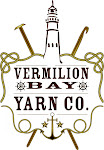You can't go too far without realizing that color work is the trend. Of course single-color garments are always in, but now more than ever, more and more design collections and pattern anthologies are offering a wide selection of multi-color options. Argyles, stripes, paisleys, as well as traditional Scandinavian style fair isle designs. Even though using a single yarn/color will create a beautiful and appealing garment, a project that requires two or more colors will stretch your creativity and open up new vistas in your knitting. There are various ways to achieve colored fabric. The most basic method is simply to use a varigated yarn, in which lengths are dyed in sequence to create a marbled, random spread of colors throughout. Jacquard patterns are typically created using a stranding technique called Fair Isle, for which yarns are carried or "floated" along the back of the fabric until they are needed. Fabric that features large areas of contrasting color requires a specific technique called Intarsia. Spaces more than 3-5 stitches wide increase the likelihood that floated strands will either cause the fabric to pucker or produce loose garlands of strands that will snag and add extra thickness to the piece.
 |
| Butterflies hanging in order |
 |
| Twist Old and New Color |
To attach the butterfly to your piece, simply hold the working end of the bundle up to your work, and start knitting, leaving a 6-8" tail that you will use to weave the hole that will normally form at the attachment spot (more about that in a bit). The butterflies hang from the needles along the row in the exact order you'll need them. The secret to keeping everything orderly is in not allowing the butterflies to hang down much more than 8" or so from the needles. Too much yarn between the butterflies and the needle will encourage the strands to twist around other strands and cause a tangle. Shorter lengths are harder to tangle. As you work the row, pick up the strand you need according to your color pattern. When you move from one color area to the next, it is vital that you establish a connection between stitches of different colors. In knitting, each stitch is connected by the working yarn as you move from stitch to stitch. With different colors/yarns, you are working with multiple working yarns and therefore you much establish a connection between them yourself. Otherwise, there will be a hole in the fabric (like the area where you joined a new butterfly) that you'll have to weave closed later. When you knit the last stitch of a color area, pick up the new color and twist the strand of new and old color so that they interlock. Continue in the new color. The twist will connect the two color areas and give the illusion of one continuous working yarn. As you continue your color pattern, you will see the yarn wraps on the back of the fabric along the edges of the color areas.
When hiding the tails in the place where a new butterfly/color was attached, you must NOT just tie a knot between two yarns. Knotting the yarns here will pull the fabric and distort the stitches. With the tail in a yarn needle, you must actually weave in the ends to establish a connection between the color areas and close of up the hole. Follow the progress of the yarn in the fabric and mimic how it would travel. The sign of a good weaving/finishing job in Intarsia is a clean wrong side that shows a mirror image of the front with color areas neatly edged with yarn twists. There should be no knots and no tails.
An important note on undoing intarsia: Not one of us, not even one, has escaped the curse of Eden unscathed. Among a host of other reasons, sometimes we may misread the pattern or count wrong, resulting in a flaw in the pattern, which goes unnoticed (typically) until the stitch count is off several rows later. DO NOT pull your work off the needles and just start ripping. Since intarsia is a series of multiple working yarns twisted around each other, drastic frogging will do nothing more than tangle your work. In order to undo this color work, you must unknit ("tink") each stitch back to the mistake. Besides tangling the yarn, drastic ripping off the needles will cause the fabric to unravel in all directions, not just stitch by stitch.
Intarsia knitting creates vibrant and extremely beautiful garments. It does take a bit of practice to master the yarn twists and to maintain your tension at the joins. As with most things, the only way to master it is to do it. And to be patient while you're at it. The more practice you allow yourself, the more proficient you'll get. Try adding some intarsia onto a hat or a small patch on a sweater, scarf or wrap. Intarsia also allows you to create marvelous color blocking effects on garments. Be creative!









1 comment:
My name is.Mrs.Anna Daniel. I live in Ukraine i am a happy woman today? i need to use this time to tell all people how i got my loan from this honest and God fearing man loan lender that help me with a loan of $84,000 please contact him. if you also need a loan without any problem he name is Dr Purva Pius email {urgentloan22@gmail.com} tell him that is Mrs.Anna Daniel that refer you to he contact Email {urgentloan22@gmail.com}
Post a Comment